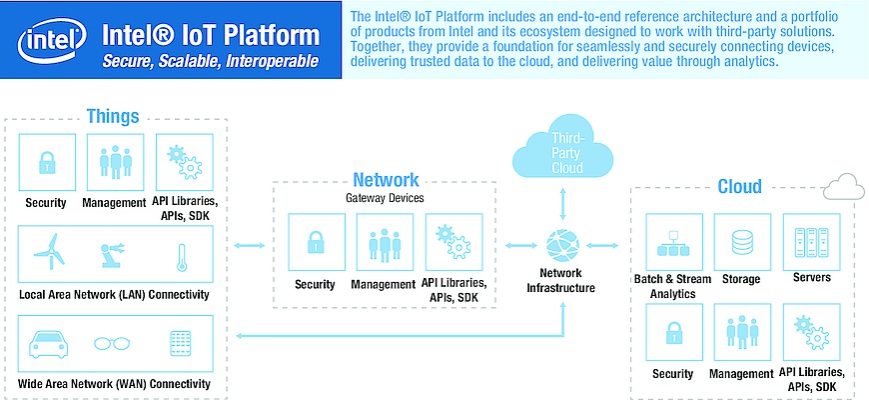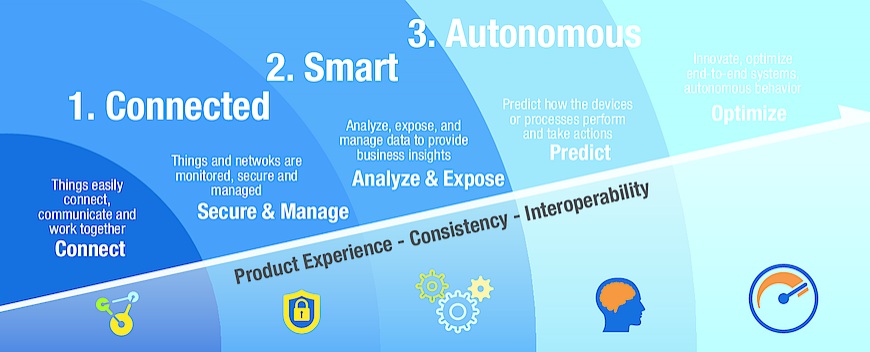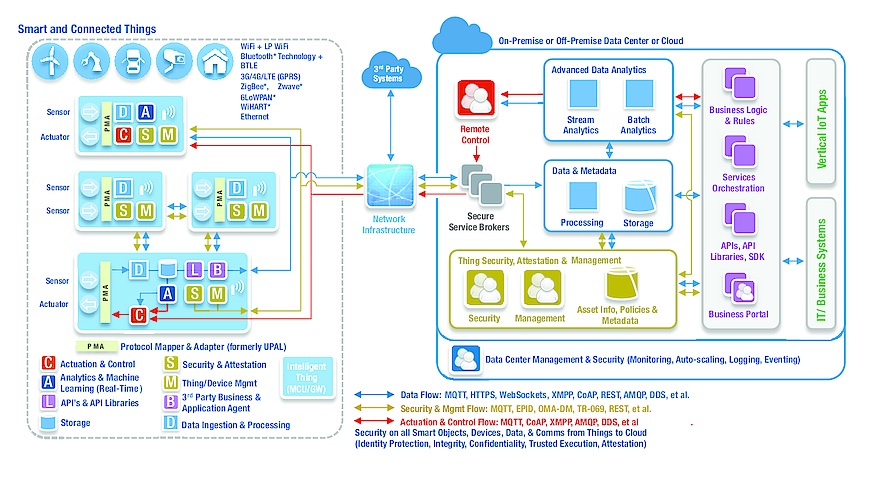Seeing Clearly in the Fog
The rapid evolution of the Internet of Things (IoT) is revealing its first signs of stress. The proliferation of connected things and the data they generate are burdening wireless networks, running up corporate cloud processing and storage costs, and exposing gaps in real-time analytics capabilities for critical infrastructure. To overcome these challenges, many major players in the IoT industry are embracing distributed compute, storage, and analytics system architecture models commonly referred to as “fog computing.”
In this article, we describe fog computing and discuss its advantages. We consider the guidance provided by a recent system architecture specification for distributed analytics (Figure 1). We examine how Intel supplies technologies and products that are reusable, scalable building blocks for the IoT. We look at how these solutions maximize computing capacity within the network, as well as enable IoT implementations to scale more easily and securely. We explore a use case involving a collaboration with SAP. And we talk about the role played by member companies of the Intel® Internet of Things Solutions Alliance in delivering IoT software, components, and systems for fog computing.

Figure 1. This system architecture specification from Intel provides guidance for end-to-end IoT distributed analytics.
The IoT’s Growing Pains
Market research firm IDC predicts that by 2020 the IoT will encompass more than 50 billion IP-connected devices and 212 billion sensors. This growth should continue to skyrocket beyond that date as 5G implementations bring greater bandwidth and lower latency to remote connections.
Every device connection adds more data. A Cisco presentation on the Internet of Everything reported that the world in 2014 generated a total of more than 2 exabytes (EB) of data a day – enough to fill 500,000 four-terabyte (TB) hard disk drives. The data sources cited showed how easily data accumulates:
- 1.1 billion data points per day from the 46 million smart meters in the United States
- 13 billion data samples a day from a single packaged goods manufacturing machine
- 10 terabytes (TB) of data every 30 minutes while a commercial airliner is in flight
With the world awash in so much data, IDC forecasts that within three years 50 percent of IT networks will transition from having excess capacity to being network constrained. Nearly 10 percent of sites will be overwhelmed.
Handling Fast Data Faster
Another key factor driving interest in fog computing is the need to handle “fast data” – data that requires real-time analysis. Factories using IoT controllers for precision operation and control response need fast-reacting IoT loops to prevent costly errors and waste. Smart grid fault detection, isolation, and restoration applications require instant response to prevent service disruptions. Automotive adaptive cruise control systems need to make millisecond adjustments in the distance between cars.
Less critical forms of data also require fast results. Consider a facial recognition-controlled doorway. To satisfy building tenants, it must operate nearly instantaneously.
How Fog Computing Helps
Fog computing puts computation, communication, control, storage, and services closer to edge devices and systems. Implemented in the edge-to-cloud space where tasks are performed, it enables operational decisions to be made locally, often autonomously, and in real or near-real time.
Fog computing’s edge analytics and filtering enable selective transmission of data – a smart strategy for many applications. For instance, instead of temperature sensors transmitting data every second to the cloud, fog computing enables forwarding of only summary and exception data that contributes to business insight. This reduces network traffic and cloud costs.
In November 2015, a coalition of IoT leaders – Intel, ARM, Cisco, Dell, Microsoft, and the Princeton University Edge Laboratory – formed the OpenFog Consortium to accelerate the deployment of fog technologies. Intel is providing direction on the implementation of distributed analytics that aligns to and is fully compatible with the Intel® system architecture specification (SAS).
The Intel® System Architecture Specification
Intel SAS offers guidance for connecting nearly any type of thing to the cloud, whether it has native Internet connectivity or not. Developers can use the specification to develop and deploy IoT solutions that deliver value through analytics infrastructure, seamless data ingestion and device control, automated device discovery and provisioning, and world-class security.
Intel SAS incorporates two Intel® IoT Platform reference architectures (Figure 2):
- Intel® IoT Platform Reference Architecture for Connecting the Unconnected – This architecture guides the use of IoT gateways for connecting legacy things lacking integrated intelligence, security, and Internet connectivity.
- Intel® IoT Platform Reference Architecture for Smart and Connected Things – This architecture focuses on the connection of smart things and the real-time, closed-loop control of data shared between them and the cloud.
Both reference architectures bring intelligence to endpoint things by enabling edge analytics, standards alignment, and direct-connect cloud control. Developers using these reference architectures can set up structures that analyze the data where it makes the most sense to improve efficiency, customer experiences, and decision making.

Figure 2. The Intel® system architecture specification includes two Intel® IoT reference architectures designed to help increase intelligence and IoT value over time.
Connecting the Unconnected
The Intel IoT Platform Reference Architecture for Connecting the Unconnected addresses distributed analytics through IoT gateway solutions based on Intel® IoT Gateway Technology. This technology connects endpoint things not originally built with security, intelligence, or Internet connectivity. Applications running on gateways based on this technology ingest, normalize, and secure data. They also determine how much and what data types go to the cloud, and what data needs immediate local action.
Solutions based on Intel IoT Gateway Technology strengthen the entire IoT infrastructure by enabling the fog to absorb the data onslaught and turn edge data into immediate value (Figure 3). Available with a wide selection of Intel® processors, the gateways provide the scalable performance to support a full range of analytics, filtering, and data ingestion tasks.

Figure 3. In fog computing, the Intel® IoT Platform’s data layer plays a key role in the distribution of analytics and control across things, network, and cloud.
Addressing Smart and Connected Things
The Intel IoT Platform Reference Architecture for Smart and Connected Things addresses the convergence of operational technology (OT) and information technology (IT). The platform enables seamless cyber-physical systems that capture data, analyze contextually relevant information in real time, and deliver business insight to the enterprise.
This Intel IoT reference architecture uses Intel IoT Gateway Technology as well to connect the unconnected, but it also employs the native intelligence of edge things capable of communicating with the cloud. For example, the architecture can tap the processing capabilities of embedded PCs, on-premise servers, IoT industrial controllers, smartphones, and wearables. Using this native intelligence reduces the cost of extending distributed analytics and storage throughout the fog.
Importance of the Data Layer
In fog computing the data layer plays a key role in the distribution of analytics and control functions for OT and IT convergence across things, network, and cloud. This layer ensures that time-sensitive data is analyzed at the node closest to the thing generating the data and needing a response. Data that can wait seconds or minutes goes to an aggregation point for analysis, action, and visualization. Data that does not require fast response and may require persistence is sent to the cloud or data center.
An Intel IoT Platform portfolio technology, Wind River* Helix* Device Cloud*, provides cloud connectivity and facilitates device management including configuration, file transfers, data capture, and rules-based data management. Intel IoT Gateway Technology comes preconfigured with Wind River Helix Device Cloud agent, one of the mechanisms for managing data flow. Device Cloud and its agent enable developers to quickly build industry-specific IoT solutions that integrate disparate enterprise IT systems.
Providing Manageability
Intel IoT Platform reference architectures include a management layer through Device Cloud. This device management platform enables automated discovery and provisioning of endpoint things to reduce the complexity of building and rolling out large-scale device deployments. Each managed thing has a management agent that executes management tasks and communicates with the cloud platform. Through gateways, Device Cloud can even manage things lacking a direct cloud connection.
Ensuring End-to-End Security
Without strong security, IoT growth will be hindered by litigation and social resistance. For end-to-end protection, Intel IoT Platform reference architectures include world-class security options spanning endpoint things, network, and cloud.
Intel Security Software acquisition McAfee provides comprehensive security software components to help developers deliver interoperable and scalable security solutions for every IoT layer. For example, McAfee Integrity Control* performs monitoring, management, and tight security policy enforcement on edge devices. McAfee Embedded Control* security technologies tightly integrate the critical hardware-based security of Intel® processors with operating system and application software security to protect data in flight or at rest. And McAfee ePolicy Orchestrator* helps automate security policy control and simplify compliance reporting.
Hardware-based security features integrated in Intel® processors provide another dimension of security. These proven solutions include Intel® vPro™technology, Intel® Trusted Execution Technology (Intel® TXT), Intel® Advanced Encryption Standard New Instructions (Intel® AES-NI), Intel® OS Guard, Intel® Software Guard Extensions, Intel® Trusted Platform Module (TPM), and Intel® Platform Protection Technology with Boot Guard and BIOS Guard.
Fog Computing in Action
Enterprise application software leader SAP uses the Intel IoT Platform reference architectures as the blueprint for a real-time analytics solution designed to generate business workflows and monitor worker safety at remote oil and gas sites (Figure 4). The fog layer of the solution uses intelligent things powered by Intel® processors to feed data to the network and gateways based on Intel IoT Gateway Technology. These gateways run SAP’s real-time analytics and Intel’s data management solutions.

Figure 4. An Intel IoT platform provides the blueprint for a real-time analytics solution from SAP for generating business workflow management and worker-safety monitoring at remote oil and gas sites.
SAP* Streaming Lite technology delivers complex event-processing capabilities to the edge. An application server hosted on the gateway provides data visualization and a browser interface. SAP* Remote Data Sync software ensures data synchronization with the SAP HANA* Cloud Platform over slow or intermittent wide area network (WAN) links for cloud-based reporting and back-end SAP integration.
The SAP solution enables rapid reaction to mechanical failures or accidents. For example, a wearable sensor could alert a worker to the presence of hazardous gases. A real-time alert could also appear on a supervisor’s compute device, along with a dashboard application providing gas levels and biometric data for other workers on the site. Additional wearable sensors could tell the supervisor if any worker is prone and motionless.
Once a stricken worker is rescued, data regarding the event could go to the cloud for trending analysis using the SAP HANA Cloud Platform. By comparing the incident with similar ones on other drilling platforms, managers could see patterns, better understand causes, and develop solutions.
The same components used in this solution – sensors, gateways, and local and cloud analytics – could be used in many other ways. For instance, temperature and pressure data could help increase uptime on sensitive machinery by alerting maintenance crews in real time to changes indicating impending failure. Event data could later undergo analytics in the cloud to inform preventive maintenance strategies.
The Fog Builders
Intel’s efforts in fog computing are supported by the more than 500 member companies of the Alliance. As part of one of the world’s most recognized and trusted technology ecosystems, these companies offer scalable hardware and software solutions fundamental to building IoT infrastructure. Through open standards and platforms, Intel and the Alliance provide developers with a wide array of competitive solutions for realizing their IoT visions through Intel SAS.
See Clearly in the Fog
As an architectural evolution from traditional closed systems and cloud-only models, fog computing is solving many IoT growing pains. It delivers significant network and cloud cost savings, as well as enables the critical execution of data analytics closer to the source for faster response times. Through Intel SAS and its two IoT reference architectures, Intel is working with Alliance members and other companies to help entire industries embrace the fog and take advantage of its benefits.